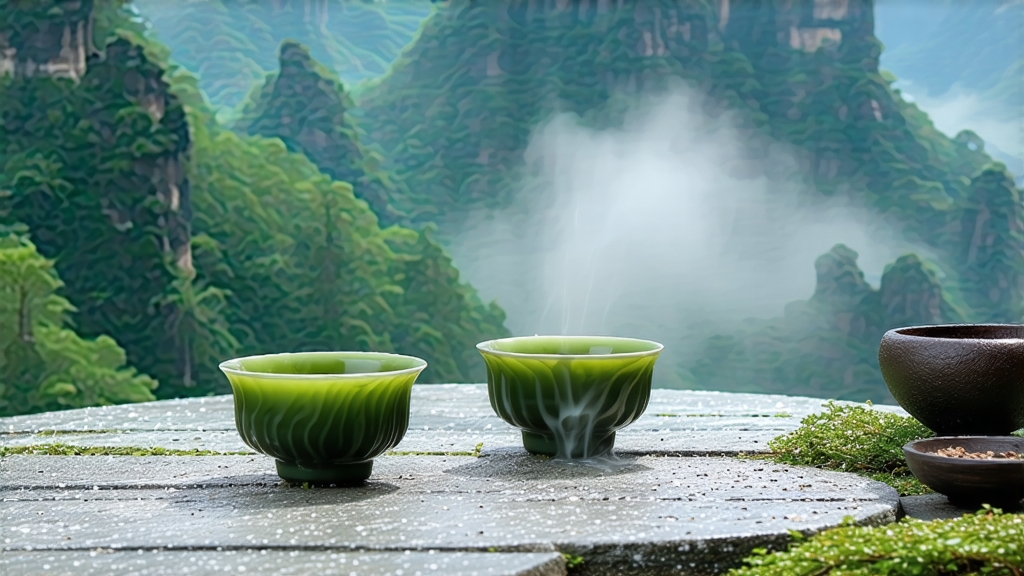
If green tea is China’s springtime and pu-erh its autumn, then Tieguanyin is the suspended moment of early dawn when the world balances between darkness and light. Named after the Bodhisattva of Compassion—Guan Yin—this oolong from southern Fujian’s Anxi county carries both spiritual serenity and the kinetic energy of centuries-old craft. To understand Tieguanyin is to witness a tea that has reinvented itself every generation while still whispering the same mountain psalms.
1. Origins: a dream, a temple, and a farmer’s guilt
Folklore places the birth of Tieguanyin in the 18th century. A poor farmer named Wei Yin, so the story goes, passed a dilapidated temple daily on his way to the fields. Though hungry, he swept the courtyard, lit incense, and prayed to the iron statue of Guan Yin. One night the Bodhisattva appeared in a dream, directing him to a cave behind the temple where a single tea shrub glimmered in moonlight. Wei cultivated the plant, shared cuttings with neighbors, and the village prospered. The tea’s leaves were heavy as iron, its aroma gentle as the goddess’s mercy—hence Tieguanyin, “Iron Guan Yin.” Historians note that Anxi farmers were already oxidizing tea during the Song dynasty; the tale merely clothes agronomic genius in sacred silk.
2. Terroir: granite bones, fog arteries
Anxi sits on the subtropical spine of the Wuyi range, 250–1,000 m above sea level. Monsoon clouds collide with granitic outcrops, creating a hydroponic mist that feeds tea bushes hour by hour. Day-night temperature swings can exceed 10 °C, slowing photosynthesis and concentrating amino acids. Later, when leaves are bruised, these compounds convert into floral lactones that give Tieguanyin its signature orchid note. The soil is lateritic, rich in iron and potassium, lending a subtle metallic finish that reminds tasters why “iron” is not just poetic but geological.
3. Cultivars: siblings under one goddess
While “Tieguanyin” is sometimes used as both cultivar and finished tea, Anxi farmers distinguish several clonal children:
- Hongxin (Red Heart): the original heirloom, low yield, high fragrance, thrives above 600 m.
- Lvxin (Green Heart): more frost-resistant, broader leaf, produces creamier infusions.
- Waiwei Tao (Out-of-Wei Peach): a naturally mutated offshoot with peach-tinged young leaves and a honeysuckle finish.
Each cultivar is grafted onto mother bushes that are centuries old, ensuring genetic continuity while allowing micro-evolutionary tweaks.
4. Craft: the choreography of oxidation
Tieguanyin’s processing is a 24-hour ballet of wilting, stressing, and calming. After morning picking, leaves are spread on bamboo trays to sun-wilt for 30–60 minutes depending on cloud cover. Hand-tossing in rectangular bamboo drums follows; edges bruise, releasing enzymes that oxidize lipids into jasmine and linalool compounds. Oxidation is arrested at 30–50 %—far higher than green tea, far lower than black—by a 280 °C tumble in gas-fired woks. The kill-green phase lasts only three minutes, just long enough to lock in floral aromatics without baking the leaf. Next comes rolling: cloth-wrapped nuggets are twisted under mechanical pressure, rupturing cell walls so that oils migrate to the surface. A final 60 °C bake for six hours reduces moisture to 3 %, curling leaves into the iconic dragonfly-head shape. Modern “light aroma” or “qing xiang” versions skip the heavy charcoal bake, preserving neon-green leaves and a crisp, gardenia perfume. Traditional “nong xiang” teas endure a 12-hour charcoal ember bake over lychee wood, emerging chestnut-brown and honey-rich.
5. Lexicon of flavor: from orchid to limestone
A well-made Tieguanyin offers a kinetic tasting arc. First infusion: bright top notes of white orchid and fresh cream. Second: a mineral snap akin to wet limestone, the “yan yun” or rock rhyme borrowed from Wuyi jargon. Third: a lingering coolness on the palate, “hui gan,” a mentholated sweetness that arrives 30 seconds after swallowing. Charcoal styles add layers of toasted almond